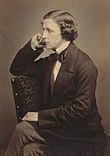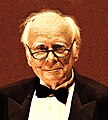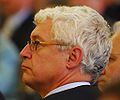Portrait photography
As a portrait photography is called a photographic genre , in which portraits of living things are made; The subjects are mostly people , and animal portraits are also often created. The aim of artistic portrait photography is usually the photographic elaboration of the character of the person.
introduction
Portrait photography is the continuation of portrait painting with photographic means. The meaning arises from different aspects:
- Portraits of historical or contemporary personalities from public life or politics shape our perception of the person.
- Those portrayed stage themselves, or the photographer stages the person.
- For professional photographers who skillfully portray famous personalities, the portrait is an important reference.
- The amount of photographs for media, photo albums, or identification documents.
Some prominent politicians employ personal photographers to ensure conceptual imagery and expression. Portraits are created during work or in the studio under controlled conditions.
Portrait photographs are often taken in the studio by professional photographers , but photography amateurs also deal with the genre.
The shoot
For studio work by professional photographers, the person has to "sit model", as in painting. The advantage of photography in such a "shoot" is the possible variation of the poses . In the dialogue between the model and the photographer, different poses are assumed until the actors are satisfied with the result. This makes certain demands on the communication and empathy of the photographer. The question arises for the person portrayed as to what he would like to reveal about himself. In digital photography, there is also a discussion about the display of photography on the computer screen as part of the work process.
Technique and method
Focal length
Special portrait lenses are telephoto lenses with a focal length between about 80 and 135 mm (based on the 35mm format ). With this focal length range, the display is perceived as pleasantly distortion-free, but not yet as “flat”, as is the case with a telephoto lens with a longer focal length or a smaller angle of view . In medium format cameras , longer focal lengths are used for portraits depending on the larger recording format, while shorter focal lengths are used for the smaller sensors of digital single-lens reflex cameras, depending on the format factor .
Light intensity
An important design option for portraits is the so-called cropping using a very shallow depth of field . For this purpose, large initial apertures are required, which is why portrait lenses in the small image area usually have initial apertures of 1: 2.8 or more; lenses with an initial aperture of 1: 1.2 are available here. With the aperture open, the face or the entire person can be optically separated from the background and, if necessary, the foreground. With a precise focus on the pupil (s), special emphasis can be placed on the eye area.
Lighting technology
In the studio, a staged illumination of the person is part of the process to control shadow formation. As a rule, softboxes are used as light sources. Various approaches to light control are used in artistic portrait photography.
Methodology of portraits
At the beginning of photography one was technically only able to depict people completely. In the course of time, the distance between the lens (camera) and the person being portrayed was steadily shortened, so that the face and / or facial features increasingly came to the fore. The images were described as follows: the visible part of the person being portrayed and the viewing direction defined from the point of view of the viewer. The following examples come from the portrait collection of the Humboldt University .
- Full-length portrait digitized
- Three-quarter figure to the half-left, standing digitized
- Elbow head en face digitized , digitized
- Elbow after half-left digitization
- Elbow after half right digitization
- Half figure to half left digitized , digitized
- Half figure after half right digitized , digitized
- Full-length portrait in front view digitized
- Half-length portrait digitized to the right
- Half-length portrait digitized to the left
- Headpiece in front view digitized
- Head piece after half left digitized , digitized
Examples of the portrait technique of people
Frontal view / full shot: Loriot
Half profile: Leonard Bernstein
Side profile with a strong upward view ( John F. Kennedy )
Profile: Giovanni Kessler
Lost profile: Marie Spartali Stillman
Cesare Zavattini portrayed by Paolo Monti
Staging: Frances Benjamin Johnston portrays himself (1896)
Occupation: Giacomo Puccini at the pianoforte
Examples of the portrait technique of animals
History and Development


Portrait photography was of great importance for early photography. The main problem of long exposure times was solved by using special fixing and holding devices such as Saronny's universal head holder . However, a great deal of patience was still required in the portrayal.
The motif often formed the basis of progress in photography. The first motif after the disclosure of Louis Daguerre's patent was from 1840 the depiction of people as a continuation of portraiture . The image design was retained for the next three decades. Many of those who invested in a camera were portrait and miniature painters . The technical development of the camera technology and the chemical processes for the development of the photographic material represented the progress. The first camera lenses made it possible to take pictures of standing people.
Photography experienced a huge surge in popularity in the late 1850s to the early 1860s. The French photographer André Adolphe-Eugène Disdéri can be named as responsible for this. He was of the opinion that a photographic portrait was unattainably expensive for many people. His idea to change this is based on the development of a smaller format than previously used (approx. 6 × 9 cm), called the carte de visite and patented it in 1854. The challenge then consisted of technical implementation, increasing productivity and reducing costs. After he succeeded in doing this, many photographic studios adopted the Carte de visite or the visit format in their offer. In May 1859 Disdéri had Emperor Napoleon III. and be able to portray his wife . This event also contributed to the popularity, as it was not customary for personalities to be shown on such small formats. Portrait photography thus contributed to the democratization of society.
Portraits were made in studios until the 1880s. The photographers Hugo Erfurth and Rudolf Dührkoop were among the first Germans to leave their studio for portraits in order to take pictures.
Basically, portrait photographs reflect a zeitgeist or a contemporary aesthetic.
Special forms
A variant of applied portrait photography can be found in criminology , where such images are produced in anthropometry and for the production of wanted posters and passport photos . With the prints of the photos of homeless people from the years 1852-1853 by the Bernese photographer Carl Durheim , the world's first wanted book was created.
In nude photography , there is overlap for portrait photography, when the face is an essential pixel.
Legal Aspects
In the German Reich there was a draft law for the first time in 1902, which granted a “ right to one's own image ”; see also image rights .
Portraits designed by professional photographers
Étienne Carjat : Portrait of Charles Baudelaire (ca.1862)
Nadar : Portrait of George Sand (1864)
Nadar: Portrait of Claude Monet (1899)
Carl van Vechten : Bessie Smith (1936)
Helmut Newton : Portrait of Laurel Martyn (1952)
Well-known portrait photographers
See also
literature
- Scott Kelby: Scott Kelby's Portrait Retouching Tricks for Photoshop . Addison-Wesley Sept. 2011. ISBN 978-3-8273-3082-6
- Cora Banek / Georg Banek: Digital Photo Practice . People and portrait . Galileo Design Verlag. ISBN 3-89842-807-9
- Duncan Evan: Digital portrait photography . Rowohlt 2004. ISBN 3-499-61239-9
- Roger Hicks and Frances Schultz: Portrait Photography . Laterna Magica 1997. ISBN 3-87467-700-1
- Terry Hope: Portraits: The Art of Black and White Photography . Laterna Magica 2000. ISBN 3-87467-762-1
- Klaus Honnef (ed.): Light portraits. The portrait in photography . Rheinland-Verlag GmbH, Cologne 1982. ISBN 3-7927-0661-X
Web links
Individual evidence
- ↑ see also classification of portraits in portrait painting .
- ^ Enno Kaufhold: The photographic portrait as a mirror of society . In: The portrait in the XX. Century . DHM, 2005, p. 10, ISBN 3-86102-137-4






















